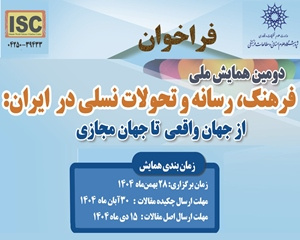گونه شناسی تحلیلی تفریحات سلطنتی سلجوقیان ایران (431 – 590 ق/1040 – 1194 م) (مقاله علمی وزارت علوم)
درجه علمی: نشریه علمی (وزارت علوم)
آرشیو
چکیده
سلجوقیان به عنوان بنیانگذارانِ یکی از دیرپاترین و تأثیرگذارترین دودمان های تاریخ میانه ایران، تا قبل از دستیابی به قدرت، در قامت جنگاوران قبیله ای، تحت سیطره حکومت های غالباً ترک تبار بودند. آنان در این دوره نه تنها با برخی از گونه های تفریحی که نزد ترکان مرسوم بود، آشنایی داشتند، بلکه متناسب با نوع این تفریحات و وضعیت خود، برخی از این سرگرمی ها را نیز انجام می دادند. قدرت یابی این قوم در ایران، شرایط مناسبی را برای بهره مندی آنان از مزیت های قدرت همچون کامرانی و خوشگذرانی فراهم کرد. پژوهش پیش رو تلاش دارد، با استفاده از روش تاریخی، به شناسایی و تحلیل تفریحات سلطنتی این عصر بپردازد. دستاوردهای تحقیق نشان می دهد سران سلجوقی و سایر وابستگان به دربار این حکومت، با اتکا به سه مؤلفه قدرت، ثروت و فرهنگ غنی ایرانی اسلامی، به تلفیق گونه های تفریحی سابق با تفریحات رایج در ایران پرداختند و از تمام ظرفیت های تفریحاتی همچون شکار، طنزپردازی، سیر و سیاحت، اسب دوانی، چوگان و شطرنج به منظور نشاط افزایی و شادی آفرینی بهره بردند. میزان استقبال آنان از این تفریحات تحت تأثیر مؤلفه هایی مانند علایق شخصی، ثبات یا ناپایداری دوره حکمرانی، ماهیت گونه های تفریحی و مطابقت یا مغایرت این گونه ها با عرف جامعه و احکام اسلام بود.Analytical typology of the Seljuk royal entertainments of Iran (1040 - 1194 AD)
As the founders of one of the longest-lasting and most influential dynasties in the history of Middle Iran, the Seljuqs were tribal warriors under the control of mostly Turkic governments before gaining power. In this period, they were not only familiar with some types of entertainment that were common among Turks, but also performed some of these entertainments according to the type of these entertainments and their status. The gaining of power of this people in Iran provided suitable conditions for them to benefit from the advantages of power such as camaraderie and fun. The present research tries to identify and analyze the royal pastimes of this era using the historical method. The results of the research show that the Seljuk leaders and other dependents of this government, relying on the three components of power, wealth and rich Iranian-Islamic culture, combined the former types of entertainment with the common entertainments in Iran and with all their capacity. They used recreational activities such as hunting, comedy, hiking, horse racing, polo and chess in order to make people happy. The extent of their acceptance of these entertainments was influenced by factors such as personal interests, the stability or instability of the ruling period, the nature of the types of entertainment and the compatibility or contradiction of these types with the customs of the society and the rules of Islam.








